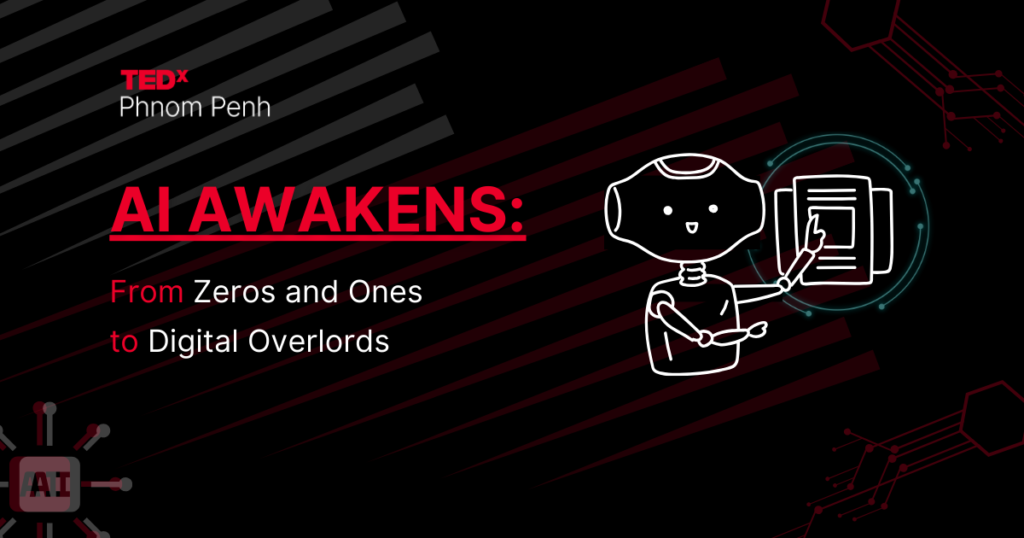
[English]
AI, AI… what exactly is AI? I’m certain you have come across this term at some point. Back in 2017, there was quite a stir when two AI robots had to be shut down because they started communicating in a language that their developers couldn’t comprehend. This incident made headlines and grabbed everyone’s attention. But why did it frighten the developers so much? Let’s delve into the immense power of AI and explore what makes it so intimidating to them. Before we proceed, let’s examine the emergence of AI and its wide-ranging applications.
The existence of AI is thanks to Alan Turing who was the first person to carry out substantial research in the field that he called Machine Intelligence. Artificial intelligence was founded later as an academic discipline in 1956 at a workshop organized by John McCarthy at the Dartmouth Summer Research Project. The goal was to investigate ways in which machines could be made to simulate aspects of intelligence—the essential idea that has continued to drive the field forward ever since.
Let’s take a look at the applications of Artificial intelligence (AI) that have a wide range of applications across various industries and domains. Such as:
- Natural Language Processing (NLP), AI is used in NLP to analyze and understand human language. It powers applications such as speech recognition, machine translation, sentiment analysis, and virtual assistants like Siri and Alexa.
- Image and Video Analysis, AI techniques, including computer vision, enable the analysis and interpretation of images and videos. This finds application in facial recognition, object detection and tracking, content moderation, medical imaging, and autonomous vehicles.
- Robotics and Automation, AI plays a crucial role in robotics and automation systems. Robots equipped with AI algorithms can perform complex tasks in manufacturing, healthcare, logistics, and exploration. They can adapt to changing environments, learn from experience, and collaborate with humans.
- Recommendation Systems, AI-powered recommendation systems are used in e-commerce, streaming platforms, and social media to personalize user experiences. They analyze user preferences, behavior, and historical data to suggest relevant products, movies, music, or content.
- Financial Services, AI is extensively used in the finance industry for fraud detection, algorithmic trading, credit scoring, and risk assessment. Machine learning models can analyze vast amounts of financial data to identify patterns and make predictions.
- Healthcare, AI applications in healthcare include disease diagnosis, medical imaging analysis, drug discovery, personalized medicine, and patient monitoring. AI can assist in identifying patterns in medical data and provide insights for better diagnosis and treatment.
- Virtual Assistants and Chatbots, AI-powered virtual assistants and chatbots interact with users, understand their queries, and provide relevant information or perform tasks. They are used in customer support, information retrieval, and personalized assistance.
- Gaming, AI algorithms are employed in gaming for creating realistic virtual characters, opponent behavior, and intelligent decision-making. AI is also used to optimize game graphics, physics simulations, and game testing.
- Smart Homes and IoT, AI enables the development of smart home systems that can automate tasks, control devices, and learn from user preferences. AI can enhance the functionality and efficiency of Internet of Things (IoT) devices and networks.
- Cybersecurity, AI helps in detecting and preventing cyber threats by analyzing network traffic, identifying anomalies, and predicting potential attacks. It can enhance the security of systems and data through advanced threat detection and response mechanisms.
With great power comes great responsibility. The potential held by AI is immense. However, The interaction between two AI-powered robots raises concerns because they can develop unique languages and behaviors, leading to unintended consequences. This phenomenon, known as “AI language divergence,” makes it difficult to fix issues. There is also a fear that the robots may collaborate in harmful ways and amplify negative behaviors. Developers use monitoring, predefined rules, and testing to stay in control. It’s important to find a balance between letting the robots act independently and having human oversight to avoid bad outcomes.
To sum up, AI holds both tremendous promise and potential pitfalls. On the positive side, AI has the potential to revolutionize industries, improve efficiency, and enhance our daily lives. It can lead to breakthroughs in healthcare, transportation, and environmental sustainability. AI-powered automation may free humans from mundane tasks, allowing for more creative and fulfilling work. However, there are concerns. AI’s rapid advancement raises ethical dilemmas, including privacy invasion, algorithmic bias, and job displacement. Overreliance on AI systems without proper oversight could lead to unintended consequences. Striking a balance between embracing AI’s benefits while addressing its negative implications is crucial for shaping a positive future.
[Khmer]
AI, AI… តើអ្វីទៅជាAI? ខ្ញុំដឹងថាអ្នកអានប្រាកដជាធ្លាប់បានឮពាក្យនេះនៅកន្លែងណាមួយមិនខាន។ ត្រឡប់ទៅកាលពីឆ្នាំ២០១៧ មានរឿងកើតឡើងយ៉ាងក្តៅគគុកមួយនៅពេលដែល អេអាយរ៉ូបតពីរត្រូវបានគេបិទជាបន្ទាន់ បន្ទាប់ពីគេចាប់អារម្មណ៍ថាពួកវាបានសន្ទនាក្នុងភាសាមួយដែលអ្នកបច្ចេកទេសមិនអាចស្តាប់បាន។ ករណីហេតុការណ៍មួយនេះបានក្លាយជាព័ត៌មានទំព័រមុខមួយដែលឆក់យកចំណាប់អារម្មណ៍អ្នកគ្រប់គ្នា។ ប៉ុន្តែហេតុអ្វីបានជាវាធ្វើអោយអ្នកបច្ចេកទេសមានប្រតិកម្មបែបនេះ? តោះទៅស្វែងយល់ពីថាមពលដ៏ធំធេងរបស់ AI ហើយស្វែងយល់ពីអ្វីដែលធ្វើឱ្យវាគួរឱ្យភ័យខ្លាចចំពោះពួកគេ។ មុននឹងយើងបន្ត សូមពិនិត្យមើលការលេចចេញនៃ AI និងកម្មវិធីទូលំទូលាយរបស់វា។
វត្តមាននៃ AI គឺអរគុណដល់ Alan Turing ដែលជាមនុស្សដំបូងគេដែលធ្វើការស្រាវជ្រាវយ៉ាងច្រើននៅក្នុងវិស័យដែលគាត់ហៅថា Machine Intelligence។ បញ្ញាសិប្បនិម្មិតត្រូវបានបង្កើតឡើងនៅពេលក្រោយជាវិន័យសិក្សានៅក្នុងឆ្នាំ 1956 នៅក្នុងសិក្ខាសាលាមួយដែលរៀបចំដោយ John McCarthy នៅ Dartmouth Summer Research Project។ គោលដៅគឺដើម្បីស៊ើបអង្កេតវិធីដែលម៉ាស៊ីនអាចត្រូវបានធ្វើឡើងដើម្បីក្លែងធ្វើទិដ្ឋភាពនៃភាពវៃឆ្លាត ដែលជាគំនិតសំខាន់ដែលបានបន្ត។ ជំរុញវិស័យនេះទៅមុខតាំងពីពេលនោះមក។
សូមក្រឡេកមើលកម្មវិធីបញ្ញាសិប្បនិម្មិត (AI) ដែលមានកម្មវិធីយ៉ាងទូលំទូលាយនៅទូទាំងឧស្សាហកម្ម និងដែនផ្សេងៗ។ ដូចជា:
- ដំណើរការភាសាធម្មជាតិ (NLP) AI ត្រូវបានប្រើនៅក្នុង NLP ដើម្បីវិភាគ និងយល់ពីភាសារបស់មនុស្ស។ វាផ្តល់ថាមពលដល់កម្មវិធីដូចជា ការទទួលស្គាល់ការនិយាយ ការបកប្រែម៉ាស៊ីន ការវិភាគមនោសញ្ចេតនា និងជំនួយការនិម្មិតដូចជា Siri និង Alexa ជាដើម។
- ការវិភាគរូបភាព និងវីដេអូ បច្ចេកទេស AI រួមទាំងចក្ខុវិស័យកុំព្យូទ័រ បើកការវិភាគ និងការបកស្រាយរូបភាព និងវីដេអូ។ វាស្វែងរកកម្មវិធីក្នុងការសម្គាល់ផ្ទៃមុខ ការរកឃើញ និងការតាមដានវត្ថុ ការសម្របសម្រួលខ្លឹមសារ រូបភាពវេជ្ជសាស្ត្រ និងយានយន្តស្វ័យប្រវត្តិ។
- មនុស្សយន្ត និងស្វ័យប្រវត្តិកម្ម AI ដើរតួនាទីយ៉ាងសំខាន់នៅក្នុងប្រព័ន្ធមនុស្សយន្ត និងស្វ័យប្រវត្តិកម្ម។ មនុស្សយន្តដែលបំពាក់ដោយ AI algorithms អាចបំពេញការងារស្មុគស្មាញក្នុងការផលិត ការថែទាំសុខភាព ភស្តុភារ និងការរុករក។ ពួកគេអាចសម្របខ្លួនទៅនឹងការផ្លាស់ប្តូរបរិយាកាស រៀនពីបទពិសោធន៍ និងសហការជាមួយមនុស្ស។
- ប្រព័ន្ធអនុសាសន៍ ប្រព័ន្ធណែនាំដែលដំណើរការដោយ AI ត្រូវបានប្រើនៅក្នុងពាណិជ្ជកម្មអេឡិចត្រូនិក វេទិកាស្ទ្រីម និងប្រព័ន្ធផ្សព្វផ្សាយសង្គម ដើម្បីធ្វើបដិរូបកម្មបទពិសោធន៍របស់អ្នកប្រើប្រាស់។ ពួកគេវិភាគចំណូលចិត្តរបស់អ្នកប្រើប្រាស់ អាកប្បកិរិយា និងទិន្នន័យប្រវត្តិសាស្ត្រ ដើម្បីណែនាំផលិតផល ភាពយន្ត តន្ត្រី ឬខ្លឹមសារដែលពាក់ព័ន្ធ។
- សេវាកម្មហិរញ្ញវត្ថុ AI ត្រូវបានប្រើប្រាស់យ៉ាងទូលំទូលាយនៅក្នុងឧស្សាហកម្មហិរញ្ញវត្ថុសម្រាប់ការរកឃើញការក្លែងបន្លំ ការជួញដូរក្បួនដោះស្រាយ ការដាក់ពិន្ទុឥណទាន និងការវាយតម្លៃហានិភ័យ។ គំរូសិក្សាម៉ាស៊ីនអាចវិភាគទិន្នន័យហិរញ្ញវត្ថុយ៉ាងច្រើនដើម្បីកំណត់អត្តសញ្ញាណគំរូ និងធ្វើការព្យាករណ៍។
- ការថែទាំសុខភាព កម្មវិធី AI ក្នុងការថែទាំសុខភាពរួមមានការធ្វើរោគវិនិច្ឆ័យជំងឺ ការវិភាគរូបភាពវេជ្ជសាស្ត្រ ការរកឃើញថ្នាំ ឱសថផ្ទាល់ខ្លួន និងការត្រួតពិនិត្យអ្នកជំងឺ។ AI អាចជួយក្នុងការកំណត់អត្តសញ្ញាណគំរូនៅក្នុងទិន្នន័យវេជ្ជសាស្រ្ត និងផ្តល់នូវការយល់ដឹងសម្រាប់ការធ្វើរោគវិនិច្ឆ័យ និងការព្យាបាលកាន់តែប្រសើរ។
- ជំនួយការនិម្មិត និង Chatbots ជំនួយការនិម្មិតដែលដំណើរការដោយ AI និង chatbots ធ្វើអន្តរកម្មជាមួយអ្នកប្រើប្រាស់ ស្វែងយល់ពីសំណួររបស់ពួកគេ និងផ្តល់ព័ត៌មានពាក់ព័ន្ធ ឬបំពេញការងារ។ ពួកវាត្រូវបានប្រើក្នុងការគាំទ្រអតិថិជន ការទាញយកព័ត៌មាន និងជំនួយផ្ទាល់ខ្លួន។
- ការលេងហ្គេម ក្បួនដោះស្រាយ AI ត្រូវបានប្រើប្រាស់ក្នុងការលេងហ្គេម ដើម្បីបង្កើតតួអង្គនិម្មិតជាក់ស្តែង អាកប្បកិរិយារបស់គូប្រជែង និងការសម្រេចចិត្តដ៏ឆ្លាតវៃ។ AI ក៏ត្រូវបានប្រើប្រាស់ផងដែរ ដើម្បីបង្កើនប្រសិទ្ធភាពក្រាហ្វិកហ្គេម ការក្លែងធ្វើរូបវិទ្យា និងការធ្វើតេស្តហ្គេម។
- Smart Homes និង IoT, AI អនុញ្ញាតឱ្យបង្កើតប្រព័ន្ធផ្ទះឆ្លាតវៃ ដែលអាចធ្វើកិច្ចការដោយស្វ័យប្រវត្តិ គ្រប់គ្រងឧបករណ៍ និងរៀនពីចំណូលចិត្តរបស់អ្នកប្រើប្រាស់។ AI អាចបង្កើនមុខងារ និងប្រសិទ្ធភាពនៃឧបករណ៍ និងបណ្តាញ Internet of Things (IoT)។
- សុវត្ថិភាពតាមអ៊ីនធឺណិត AI ជួយក្នុងការស្វែងរក និងការពារការគំរាមកំហែងតាមអ៊ីនធឺណិត ដោយការវិភាគចរាចរណ៍បណ្តាញ កំណត់អត្តសញ្ញាណភាពមិនប្រក្រតី និងព្យាករណ៍ពីការវាយប្រហារដែលអាចកើតមាន។ វាអាចបង្កើនសុវត្ថិភាពនៃប្រព័ន្ធ និងទិន្នន័យតាមរយៈការរកឃើញការគំរាមកំហែងកម្រិតខ្ពស់ និងយន្តការឆ្លើយតប។
ជាមួយនឹងថាមពលដ៏អស្ចារ្យ ការទទួលខុសត្រូវក៏ធំទៅតាមនោះដែរ។ សក្តានុពលដែលគ្រប់គ្រងដោយ AI គឺធំធេងណាស់។ ទោះជាយ៉ាងណាក៏ដោយ អន្តរកម្មរវាងមនុស្សយន្តដែលដំណើរការដោយ AI ពីរបានធ្វើឱ្យមានការព្រួយបារម្ភ ដោយសារតែពួកគេអាចអភិវឌ្ឍភាសា និងអាកប្បកិរិយាប្លែកៗ ដែលនាំឱ្យមានផលវិបាកដោយអចេតនា។ បាតុភូតនេះត្រូវបានគេស្គាល់ថាជា “ភាពខុសគ្នានៃភាសា AI” ធ្វើឱ្យមានការលំបាកក្នុងការជួសជុលបញ្ហា។ វាក៏មានការភ័យខ្លាចផងដែរដែលថាមនុស្សយន្តអាចសហការគ្នាក្នុងវិធីបង្កគ្រោះថ្នាក់ និងពង្រីកអាកប្បកិរិយាអវិជ្ជមាន។ អ្នកអភិវឌ្ឍន៍ប្រើប្រាស់ការត្រួតពិនិត្យ ច្បាប់ដែលបានកំណត់ជាមុន និងការធ្វើតេស្តដើម្បីរក្សាការគ្រប់គ្រង។ វាមានសារៈសំខាន់ណាស់ក្នុងការស្វែងរកតុល្យភាពរវាងការអនុញ្ញាតឱ្យមនុស្សយន្តធ្វើសកម្មភាពដោយឯករាជ្យ និងមានការត្រួតពិនិត្យពីមនុស្ស ដើម្បីជៀសវាងលទ្ធផលអាក្រក់។
សរុបសេចក្តីមក AI មានទាំងអត្ថប្រយោជន៌អស្ចារ្យ និងបញ្ហាដែលអាចកើតមាន។ នៅលើផ្នែកវិជ្ជមាន AI មានសក្តានុពលក្នុងការធ្វើបដិវត្តន៍ឧស្សាហកម្ម ធ្វើអោយប្រសើរឡើងនូវប្រសិទ្ធភាព និងលើកកម្ពស់ជីវិតប្រចាំថ្ងៃរបស់យើង។ វាអាចនាំឱ្យមានរបកគំហើញក្នុងការថែទាំសុខភាព ការដឹកជញ្ជូន និងនិរន្តរភាពបរិស្ថាន។ ស្វ័យប្រវត្តិកម្មដែលដំណើរការដោយ AI អាចរំដោះមនុស្សចេញពីកិច្ចការដែលគួរអោយធុញទ្រាន់ ដែលអនុញ្ញាតឱ្យមានការងារប្រកបដោយភាពច្នៃប្រឌិត និងបំពេញបន្ថែម។ ទោះយ៉ាងណាក៏ដោយមានការព្រួយបារម្ភ។ ការរីកចម្រើនយ៉ាងឆាប់រហ័សរបស់ AI បង្កើនបញ្ហាក្រមសីលធម៌ រួមទាំងការលុកលុយឯកជនភាព ភាពលំអៀងនៃក្បួនដោះស្រាយ និងការផ្លាស់ទីលំនៅការងារ។ ការពឹងផ្អែកខ្លាំងលើប្រព័ន្ធ AI ដោយគ្មានការត្រួតពិនិត្យត្រឹមត្រូវអាចនាំឱ្យមានផលវិបាកដោយអចេតនា។ ការធ្វើឱ្យមានតុល្យភាពរវាងការទទួលយកអត្ថប្រយោជន៍របស់ AI ខណៈពេលដែលការដោះស្រាយផលប៉ះពាល់អវិជ្ជមានរបស់វាគឺមានសារៈសំខាន់សម្រាប់ការបង្កើតអនាគតវិជ្ជមាន។
